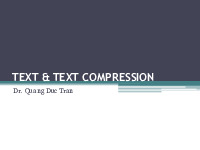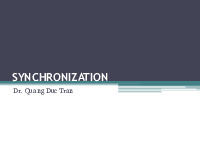



















Preview text:
VIDEO AND VIDEO COMPRESSION Dr. Quang Duc Tran Analog Video
• A video signal is a sequence of two dimensional (2D)
images projected from a dynamic three dimensional
(3D) scene onto the image plane of a video camera.
• A video records the emitted and/or reflected light
intensity from the objects. The intensity changes both in time and space. Composite vs. Component Video
• Ideally, a color video is specified by three function or signals,
each describing one color component. A video in this format is known as component video.
• In composite video, the three color signals are multiplexed
into a single signal. A composite signal has bandwidth that is
significantly lower than the sum of the bandwidth of three
component signals, and hence, can be stored and transmitted
efficiently. This is achieved at the expense of video quality.
• S-video consists of two components, the luminance
component and a single chrominance component. Composite vs. Component Video Analog Video Raster
• The analog TV systems of today use raster scan for video
capture and display, which can be interlaced or progressive.
• The progressive scanning scans an image sequentially
from line 1 to the final line of the raster to create a video frame.
• The interlaced scanning scans odd lines in field 1 and
even lines in field 2. Together field 1 and 2 constitute one frame. Analog Video Raster Refresh rate
• The frequency between the display of two still images is
known as the refresh rate and is expressed in Hz or frames per second.
• The movie industry uses a refresh rate of 24 frames per second.
• For a fix bandwidth, the interlaced scan provides a video
signal with twice the display refresh rate for a given line count
as compared to the progressive scan. This higher refresh rate
improves the appearance of objects motion. • However, interlaced scan causes interlacing effects if
recorded objects move fast to be in different positions when
each individual field is captured. Analog Television System Parameters NTSC PAL SECAM Field Rate 59.94 50 50 Line No./Frame 525 625 625 Line Rate (Line/s) 15,750 15,625 15,625 Luminance Bandwidth (MHz) 4.2 5.0, 5.5 6.0 Chrominance Bandwidth (MHz) 1.5 (I), 0.5 (Q) 1.3 (U,V) 1.0 (U,V) Audio Subcarrier 4.5 5.5, 6.0 6.5
Composite Signal Bandwidth (MHz) 6.0 8.0, 8.5 8.0
• HDTV enhances the visual impact by employing a wider screen
(16:9) and sampling resolution of 60 frames/s, and 720 line/frame.
• For computer display, much higher temporal and spatial sampling
rates are needed (e.g., SVGA has 72 fps and a resolution of 1024x720 pixels). Wagon-wheel effect Digital Video
• A digital video can be obtained either by sampling a
raster scan, or directly using digital video camera.
• In the BT. 601 standard, a sampling rate of 13.5 MHz is
used for both the NTSC and PAL/SECAM systems.
• BT.601 also defines a digital color coordinate, known as
YCbCr (see Chroma Sub-sampling).
• In addition to BT.601, other standards exists. For
example, CIF (Common Intermediate Format) has about half the resolution of BT.601. Video Compression
• International Telecommunication Union (ITU-T)
▫ H.261: ISDN Video Phone (px64 kb/s)
▫ H. 263: PSTN Video Phone (<64 kb/s)
▫ H.26L: A variety of applications (<64 kb/s)
Internet Video Application, VOD, Video Mail
• International Organization for Standard (ISO)
▫ MPEG-1 Video: CD-ROM (1.2 Mb/s)
▫ MPEG-2 Video: SDTV, HDTV (4-80 Mb/s)
▫ MPEG-4 Video: A variety of applications (24-1024 kb/s)
• MJEG (Moving JPEG) applies JPEG algorithm to each frame independently. Video Compression (Cont.)
• A video stream has 2 spatial and 1 temporal dimensions,
video compression is usually done independently in the
spatial dimensions and, respectively, in the time dimension.
• In the spatial dimensions – encoder tries to eliminate
spatial redundancy (like in JPEG) and typically works on 8x8 pixel image blocks.
• In the time dimension – encoder tries to eliminate
temporal redundancy (i.e. motion of objects) and
typically works on 16x16 pixel image blocks. Motion Estimation
• The references between the different types of frames are
realized by a process called motion estimation. The
correlation between two frames in terms of motion is
represented by a motion vector. Motion Estimation (Cont.)
• Good estimation of the motion vector results in higher
compression ratios and better quality of the coded video sequence.
• The actual frame is divided into non-overlapping blocks
(macro blocks) usually 16x16 pixels. The smaller the
block sizes are chosen the more motion vectors need to be calculated.
• Motion vectors are only calculated if the difference
between two blocks at the same position is higher than a threshold. Motion Estimation (Cont.)
• Block Matching tries to “stitch together” an actual predicted
frame by using blocks from previous frames.
• Each blocks of the current frame is compared with a past frame within a search area.
• Rectangular search area is used, which takes into account that
horizontal movements are more likely than vertical ones.
• Only luminance information is used to compare the blocks,
but color information will be included in the encoding. Motion Compensation
• Video motions are often complex. A simple “shifting in
2D” is not a perfectly suitable description of the motion
in the actual scene, causing so called prediction errors.
• Since the estimation is not exact, additional information
must also be sent to indicate any small differences
between the predicted and actual positions of the moving
segments involved. This is known as the motion compensation.
• Generally, less data is needed to store the differences.
Schematic Process of Motion Estimation Current Entropy DCT Quantization Bit stream Frame Coding Reference Motion Compensation Frames Frame N-1 Motion Estimation Frame N Motion Vector MPEG Standards
• MPEG-1: Initial Audio/Video Compression Standard ▫ Total bit rate: 1.5 Mbps
▫ Video: 352x240 pixels/frame, 30 frames/s
▫ Audio: 2 channels, 48,000 samples/s, 16 bits/sample
• MPEG-2: for better quality audio and video ▫ Total bit-rate: 4-80 Mbps
▫ Video: 720x480 pixels/frame, 30 frames/s
▫ Audio: 5.1 channels, Advanced Audio Coding (AAC)
• MPEG-4: for a variety of applications with a wide range of quality and bit rate
A Typical MPEG Frame Display Order Forward Motion Compensation I B B P B B P B B I
Bidirectional Motion Compensation
I-frame: Intra-coded frame
P-frame: One directional motion prediction from a previous frame
B-frame: Bi-directional motion prediction from a previous or future frame I-frames
• I-frames are encoded without reference to any other
frames. Each frame is treated as a separate picture
and the Y, Cb and Cr matrices are encoded separately using JPEG
• I-frames must be repeated at regular intervals to
avoid losing the whole picture as during
transmission it can get corrupted and hence looses the frame
• The number of frames/pictures between successive
I-frames is known as a group of pictures (GOP).
Typical values of GOP are 3 - 12



